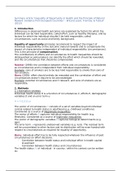Summary article ‘Inequality of Opportunity in Health and the Principle of Natural
Reward: evidence from European Countries’ – Bricard, Jusot, Trannoy, & Tubeuf
(2013)
1. Introduction
Differences in observed health outcomes are explained by factors for which the
individual can be held responsible, called effort, such as healthy lifestyles, and by
factors for which the individual shouldn’t be held responsible, called
circumstances, such as social and family background.
Equality of opportunity principles recommend to respect the impact of
individual responsibility on the outcome (natural reward) and to compensate the
impact of characteristics independent of individual responsibility (circumstances).
This is the principle of compensation.
The contributions of efforts and circumstances to health inequalities should be
distinguished so policymakers can identify the effort which should be rewarded,
and the circumstances that should be compensated.
Roemer (1998): the correlation between efforts and circumstances is considered
as circumstances and is independent from individual responsibility.
Example: sons of smokers are to be less hold responsible to smoke than sons of
non-smokers.
Barry (2005): effort should entirely be rewarded and the correlation of effort and
circumstances doesn’t require to be acknowledged.
Example: parental circumstances aren’t relevant, and sons of smokers are as
responsible.
2. Methods
2.1 Estimation strategy
Individual health status H is a function of circumstances C, efforts E, demographic
variables D and an error term u:
H = f (C,E,D,u)
The vector of circumstances C consists of a set of variables beyond individual
control related to health status in adulthood (e.g. childhood conditions).
Considered as a source of illegitimate inequalities.
The vector of efforts E captures individual responsibility for health (e.g.
lifestyles). Considered as a source of legitimate inequalities.
The vector of demographic variables D captures biological determinants (e.g.
age).
The error term u represents unobserved variables (e.g. luck). The residual term
will be uncorrelated to other factors and its distribution will be even-handed with
respect to circumstances as required for equality of opportunity.
Barry: individual effort has to be fully respected whatever the influence of past
circumstances on effort decisions.
- Correlation between health status and individual effort in health capital
investment
- Correlation between health status and circumstances
The health status Hij of individual i in country j within his context can be written
as:
, (Eq. 2) Hij = Bj + BjCij + BjEij + BDij + uij
This equation allows us to test the condition of equality of opportunity in Barry’s
view by testing the equality of âBj to zero. Independence between Cij and Eij is not
required.
Roemer: equality of opportunity requires that effort is purged from any
contamination coming from circumstances so that it represents pure individual
effort. This leads to estimate an auxiliary equation regressing the effort Eij of
individual i in country j against their circumstances Cij. It allows isolating a
residual term eij, the relative efforts, which represent individual efforts purged
from any circumstances:
(Eq. 3) Eij = j + jCij + eij
We then substitute the vector of actual efforts Eij for the estimated relative efforts
êij in the equation of health status (Eq. 2) and the health status HRij of individual i
in country j within Roemer context can be written as follows:
(Eq. 4) Hij = Bj + BjCij
This allows us to test the condition of equality of opportunity in Roemer view by
testing the equality of âRj to zero, since Cij and eij are independent.
The equations 2, 3 and 4 are estimated using linear probability models.
Predicted health is the same in the alternative specifications according to Barry
or Roemer as the set of regressors of both models contains the same information.
2.2 Inequality measurement
The variance presents a natural decomposition and has properties of
consistency, symmetry and independence of the level of disaggregation.
Four main components of health:
1. Circumstances HkC
2. Efforts HkE
3. Demographics HkD
4. Residual Hkres
The decomposition of the variance of health status 2 (H) is given by:
(Eq. 5) 2 (H) = cov(HkC,H) + cov(HkE,H) + cov(HkD,H) + cov(Hkres,H)
We use this decomposition to measure inequalities of opportunities IOPk and
inequalities related to efforts IEFk. Another measure of inequalities of
opportunities as a share of inequalities related to circumstances and efforts SOPk.
The measure of inequalities of opportunities is equal to the component of
health inequality related to illegitimate factors, namely circumstances:
(Eq. 6) IOPk = cov(HkC,H) with k= B, R
The measure of health inequality related to efforts is equal to the component
of health inequality related to legitimate factors, namely efforts:






